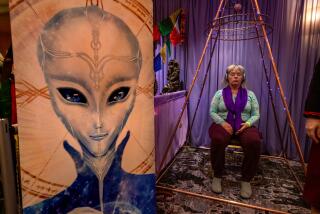New Age as Perennial Philosophy
What would you think if news organizations sent someone ignorant of football to cover the Super Bowl, or hired a reporter who knew nothing about food to be their restaurant critic? That’s what happened last year in the media’s flood-tide coverage of the New Age. For those acquainted from the inside with the truth of this story, the reportorial performance of the press, radio, and television has at worst seemed mocking, cynical, and full of ill-disguised prejudice, and at best, simply ill-informed. Inexplicably, the media sent people to report on New Age events who have no background in psychology, philosophy, metaphysics, leading-edge science, alternative medical practices, the history of transcendentalism in America, or any of the other fields related to New Age thinking. The resulting reports are not only trivial and misleading but entirely miss an important story that could offer reason to hope in a time of widespread fear.
My aim in writing this is to persuade those of you who have been convinced by the media that the New Age is simply nonsense and a passing fad, to take a second look. I’d also like to open you to an interest in the movement’s psychospiritual and humanistic perspectives and offer a glimpse of how that point of view can affect people who respond to it.
No one speaks for the entire New Age community. Within the movement, there is no unanimity as to how to define it or even that it is sufficiently cohesive to be called a movement. However, I believe that the following statements would satisfy a very large portion of the people who associate themselves with it.
First of all, don’t think of the words New Age as representing a specific period of time. It is not the Ice Age, or the Renaissance. Rather, it is a metaphor for a process of striving for personal growth through which millions of people are trying to become more fully awake to their inherent capacities.
Like every other movement, whether religious, political, economic, or philosophical, the New Age is ultimately based upon a group of assumptions about the place of humanity in the cosmos. At the heart of New Age thought is the idea that humans have many levels of consciousness and that, with the exception of a limited number of spiritual geniuses throughout history, we essentially live in a walking sleep that keeps us from a balanced, harmonious and direct relationship with God (however you understand that concept), nature, each other, and ourselves.
Broadly stated, this world view is that:
(1) The everyday world and our personal consciousness is a manifestation of a larger, divine reality; (2) humans have a suppressed, or hidden, Higher Self that reflects, or is connected to the divine element of the universe; (3) this Higher Self can be awakened and take a central part in the everyday life of the individual, and (4) this awakening is the purpose or goal of human life. This set of ideas, which Aldous Huxley called “the Perennial Philosophy,” is perhaps the oldest underlying spiritual perspective of humanity and is inherent, though often buried, in the practice of traditional religion. In this sense, the New Age is not new--it is ancient.
Most, but definitely not all, people who consider themselves in the movement feel that they have had some kind of awakening experience that changed their views of the world and of their goals in life. It has, in consequence, changed the way they live and communicate about their lives. Although it is often difficult to do so and makes them stand out in embarrassing ways, New Agers try to act upon this perspective because it seems to contain a deeper meaning than the experiences of their previously “unawakened” selves.
The process of awakening is most commonly called self-realization, enlightenment, or transformation. The transformation process is confusing, partial and uneven. The person striving for “enlightenment” does not quickly or permanently embody what these words imply, as the vision of what one might become if one were to be “enlightened” is invariably larger than the ability of the individual to contain or reflect it.
Inevitably, this preliminary self-realization, this connection to new ideas and higher values, is accompanied by a massive shaking up of the individual’s traditional perspectives. These are often replaced by more open, experimental, idiosyncratic ideas and behaviors. The media have been accurate in reporting the interest of many New Agers in reincarnation, extraterrestrial contact, crystals, psychic phenomena, channeling and, yes, even in earning a good living from various products and activities associated with them, but it has totally ignored the core of New Age thought. Focusing on fringe activities instead of the efforts at personal and social transformation that spring from a commitment to the Perennial Philosophy, the press has reported the carnival sideshow and not the acts in the big tent. Many of the leading writers and lecturers in the field do not even mention any of these peripheral elements, or do so in a historic and scientific context in which they make considerably more sense than they do in the media reports. Such presentations, however, don’t make the “good copy” that weird ideas do and so are neglected.
“What’s the matter with these New Agers?” the critics ask.
“Are they crazy?” No they are not. By and large, they are ordinary people who have shared some extraordinary experiences, who have awakened to the wider possibilities of the heart and mind, and who are trying their best to fit these perceptions into daily life in a culture that is in general unsympathetic to them.
Of course, many New Agers do not share these experiences. They are fired by such diverse passions as world peace, the preservation of nature, or simply the desire to be all that they can be. Often highly successful in their professions, innovative, normal to all outward appearances, they too are ignored because they don’t offer the possibility of an eye-catching headline.
Sadly, what also has not been written about is the tremendous contribution that the movement’s thinking and psychological technologies have made to teaching and the understanding of learning styles; to creativity and consciousness research; to healing through focusing on the mind/body connection; to business through humanistic management practices; to bettering relationships through attention to personal responsibility; and even to enhancing sports performance through visualization techniques. Most of all, the New Age continues to provide for millions a guiding vision of ways to become a more loving human being working to make a better world.
I wish the press would cover that. It’s a great story.


